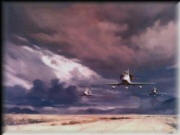|
Angle of Attack Explained |
 |
|
Angle of Attack Explained |
 |
![]()
| What is the Angle of
Attack?
No, it is not the direction from which you strike your opponent! It is defined as the angle between the chord line of the wing and the direction of the relative wind.
What good is it? The AOA (Angle of Attack) gauge in an aircraft will let the pilot know when he is at the correct approach / climbout speed. This indicator is correct even though the aircraft's weight may vary. Also, the gauge provides a visual warning of an impending stall.
How is it used? Let us say you are going to land on a runway that is short plus it is raining. You sure don't want any extra speed at touchdown. If you know your aircraft's weight (adjusted for fuel burnoff) then you could go to the aircraft manual and look up in a table the stall speed and fly your approach just above that speed. However, if you have an angle of attack gauge all you have to do is slow until the needle is close to the stall line and fly the approach! The AOA gauge is a primary instrument in an approach to a navy aircraft carrier because of it's accuracy and ease of use. What is a typical system? Here are pages from the A4 Skyhawk flight manual describing the angle of attack system on that aircraft. Summary This simple gauge will give you the indications to keep your aircraft at the correct speed on approach / climbout. As stall speed varies by weight, which can vary considerably according to fuel burn and/or ordinance drop, this instrument is essential where precise speed control is desired. Snowy Approach to Heathrow in a Boeing 727-200 using AOA and HUD
|